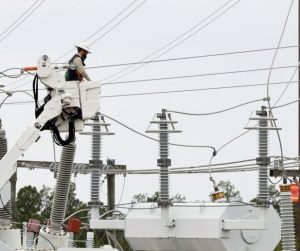KN, p. 301 “Domestic Terrorism in North Carolina”
If this post has no paragraph separations, please double-click on the title to create a more readable article.

Note: Actual current events (updated February 4, 2023)
Domestic terrorism: The FBI defines it as “violent, criminal acts committed by individuals and/or groups to further ideological goals stemming from domestic influences, such as those of a political, religious, social, racial, or environmental in nature.
The call came into the police station at 7pm on December 3, 2022, a Saturday night. I imagine that the day shift had left, the tally of parking tickets, breakdowns, and crowd control duties fairly light for a golf resort town on the weekend in the South. A local resident had become concerned when the power went out for his entire block. And then the lights flickered at the station. The officer taking the call looked up, puzzled. Coincidence? The generator kicked in and the lights came back on, the phone call still active.
I assume that the cop reassured the guy at the other end that he would look into it, mentioning that it was probably a neighborhood transformer out, in which case lights would be on pretty quickly. He might have checked the power company website but not see any reports of widespread outages. A call directly to the power company would reveal something quite different. Their internal power map would show a widespread outage getting bigger. We know that a company official told him that first they were checking into it. Backups aside, sometimes stuff just failed. We know that the power company had received a few phone calls from the public similar to the one that came into the police station and were checking those with technicians already in the field.
What was discovered not long afterward was that shots had been fired at two of the substations in the Southern Pines, Moore County, NC area, knocking out the machinery. Located about halfway between Raleigh and Fayetteville, this is normally a destination community for year round golf and shopping. Moore County Sheriff Ronnie Fields spoke publicly about curfews for the duration of the power outage and announced that it was a criminal investigation, with perpetrators who knew exactly what they were doing, with targeted shots.
Jon Wellinghoff, former head of the Federal Energy Regulatory Commission (FERC) and now CEO and Founder of Grid Policy, was quoted as saying, “Somebody with a high-powered rifle puts a bullet through the case of a transformer and once it goes into the case of the transformer it hits the coils of the transformer, shorts it out, and it’s gone; That device is no longer operable. It can’t be fixed, it needs to be replaced. It cannot be repaired.”
He spoke about the repairs needed: “A lot of these transformers also are sort of one-offs. It’s not like you can cookie-cutter replace them with another one from some other utility in the next county or the next state. They have to be made sort of custom for the particular substation that they’re in. So if they don’t have spares for that particular substation, it could take a considerable amount of time.”
Governor Roy Cooper visited and shopped in Southern Pines the day after power was restored.. When asked whether it had been a terrible prank or domestic terrorism, he said, “I think investigators are leaving no stone unturned as to what this is.”
Read more at: https://www.newsobserver.com/news/state/north-carolina/article269613951.html#storylink=cpy
The county was under curfew between 9 p.m. and 5 a.m., with schools closed and streetlights off while power was out. The temperatures dropped below 40 degrees on some nights with thousands without heat. It took until Thursday, December 8th to bring the county power back on line.
What kind of penalty do the perpetrators face if they are found and convicted?
Under federal law, damaging energy facilities that causes “a significant interruption or impairment of a function” is punishable by up to 20 years in prison.
North Carolina, along with other states, enacted their own terrorism laws a decade ago. Under this law, “felonies are elevated one class if crimes were motivated by a desire to intimidate the whole population, a specific group or the government.”
As of January 4, 2023, no arrests have been made. Governor Cooper has announced a $75,000. reward for information leading to the arrest and conviction of the perpetrators. The FBI has joined local and State authorities in the investigation of the “willful damage” and have been exploring all possibilities, both for suspects and the reason behind the damage. It won’t be known for sure what the motivation was until the culprits are caught and spoken to.
Warrants have been requested for cell phone records to indicate activity in the area on the days in question. If the public has any information about the attack on the substations, please call the Sheriff’s tip line: 910-947-4444 or contact the FBI at 1-800-CALL FBI or tips.fbi.gov.
On January 17th, there was a gunfire attack at an electrical substation in Randolph County. The two attacks do not appear to be related. On February 3, the FBI offered a reward of up to $25,000 for information on the attack.
That’s in addition to the $25,000 reward for information on the Moore County grids attack in early December.
In Randolph County, please call the Randolph County Sheriff’s Office at 336-318-6685, if you have information, or contact the FBI at 1-800- CALL FBI or tips.fbi.gov.
KN, p. 301 “Domestic Terrorism in North Carolina” Read More »


